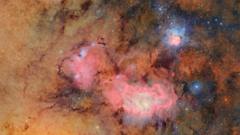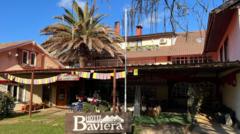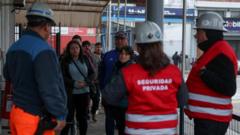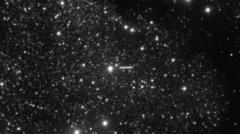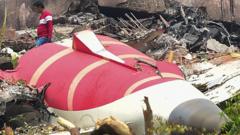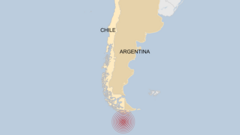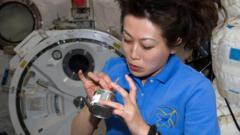The Vera C. Rubin Observatory in Chile has unveiled its first images, illustrating its groundbreaking ability to explore the expansive universe. The initial photo captures the vibrant gas and dust clouds of the Trifid and Lagoon nebulae, located approximately 9,000 light-years away from Earth. This cutting-edge telescope, which boasts the world's most advanced digital camera, is poised to revolutionize astronomical research.
Scientists suggest that if a ninth planet exists in our solar system, the Vera Rubin telescope could identify it within its first year of operation. The observatory is expected to play a pivotal role in detecting potentially hazardous asteroids near Earth and in mapping the Milky Way. Additionally, it aims to unveil critical insights into dark matter, which constitutes a significant portion of the universe.
Described as a once-in-a-generation milestone, the observatory represents the culmination of decades of dedication to large-scale astronomical surveys. Professor Catherine Heymans, Astronomer Royal for Scotland, remarked on the significance of this moment. The United Kingdom, a key collaborator, will be responsible for data centers that analyze the detailed images captured by this instrument.
The observatory is strategically located on Cerro Pachón in the Chilean Andes, a site renowned for its high altitude, dryness, and darkness — ideal conditions for stargazing. Maintaining the site’s darkness is crucial, and precautions are taken to mitigate stray lights that could interfere with observations.
The Vera Rubin telescope employs a sophisticated three-mirror design and features a 3,200-megapixel camera developed by the Department of Energy's SLAC National Accelerator Laboratory. This advanced setup enables the telescope to collect an abundance of light, providing clarity to distant objects.
The observatory's mission will include a continuous survey of the night sky specifically designed for the Legacy Survey of Space and Time. It aims to capture celestial images every 40 seconds for approximately 8–12 hours nightly over the next decade. This long-term survey is expected to facilitate an understanding of transient events and changes in the cosmos.
Each night, scientists predict that the telescope could generate around 10 million unique data alerts, prompting a ready response from the global scientific community. It will also be instrumental in identifying hazardous celestial bodies, such as asteroids that may approach Earth.
Experts believe that the telescope's capabilities could allow researchers to explore previously unseen regions of the Milky Way and perhaps unravel the mystery of the elusive Planet Nine. As Professor Heymans expressed enthusiasm for the forefront of astronomical discovery, she remarked on the transformative potential of the Vera Rubin Observatory.
For those interested in the latest developments in astronomy, this technological leap represents a significant step forward in our quest to comprehend the cosmos and explore the undiscovered mysteries that lie within it.
Scientists suggest that if a ninth planet exists in our solar system, the Vera Rubin telescope could identify it within its first year of operation. The observatory is expected to play a pivotal role in detecting potentially hazardous asteroids near Earth and in mapping the Milky Way. Additionally, it aims to unveil critical insights into dark matter, which constitutes a significant portion of the universe.
Described as a once-in-a-generation milestone, the observatory represents the culmination of decades of dedication to large-scale astronomical surveys. Professor Catherine Heymans, Astronomer Royal for Scotland, remarked on the significance of this moment. The United Kingdom, a key collaborator, will be responsible for data centers that analyze the detailed images captured by this instrument.
The observatory is strategically located on Cerro Pachón in the Chilean Andes, a site renowned for its high altitude, dryness, and darkness — ideal conditions for stargazing. Maintaining the site’s darkness is crucial, and precautions are taken to mitigate stray lights that could interfere with observations.
The Vera Rubin telescope employs a sophisticated three-mirror design and features a 3,200-megapixel camera developed by the Department of Energy's SLAC National Accelerator Laboratory. This advanced setup enables the telescope to collect an abundance of light, providing clarity to distant objects.
The observatory's mission will include a continuous survey of the night sky specifically designed for the Legacy Survey of Space and Time. It aims to capture celestial images every 40 seconds for approximately 8–12 hours nightly over the next decade. This long-term survey is expected to facilitate an understanding of transient events and changes in the cosmos.
Each night, scientists predict that the telescope could generate around 10 million unique data alerts, prompting a ready response from the global scientific community. It will also be instrumental in identifying hazardous celestial bodies, such as asteroids that may approach Earth.
Experts believe that the telescope's capabilities could allow researchers to explore previously unseen regions of the Milky Way and perhaps unravel the mystery of the elusive Planet Nine. As Professor Heymans expressed enthusiasm for the forefront of astronomical discovery, she remarked on the transformative potential of the Vera Rubin Observatory.
For those interested in the latest developments in astronomy, this technological leap represents a significant step forward in our quest to comprehend the cosmos and explore the undiscovered mysteries that lie within it.

